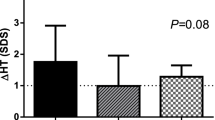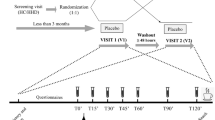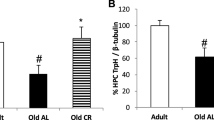Abstract
Severe tetrahydrobiopterin (BH4) deficiency is a naturally occurring model of cerebral catecholamine and serotonin short-age. Examination of the stimulated release and physiologic secretion pattern of several hormones in affected individuals permits certain conclusions concerning the involvement of these neurotransmitters in hormone regulation. Treatment, moreover, permits the ranking of the quality of the therapeutic regimens in use according to the degree of hormonal alteration. The 24-h secretion pattern of prolactin, GH, cortisol, and melatonin and the stimulated release of prolactin, GH, TSH, and gonadotropins were studied in an affected girl. Severe hyperprolactinemia with disruption of the pulsatile and circadian secretion pattern was the prevailing feature. The GH physiologic secretion pattern was not affected, but its stimulation was impaired. Melatonin displayed a normal circadian secretion pattern; the rhythm, however, was advanced by several hours. Conventional treatment of BH4 deficiency, i.e. BH4, 5-hydroxytryptophan, and L-DOPA/carbidopa (the last named given in three doses per day), suppresses prolactin levels merely for a few hours. L-DOPA/carbidopa given at shorter intervals or, even better, as a slow release preparation, is more effective in suppressing prolactin levels. Our data indicate immense hyperprolactinemia but few other hormonal disturbances in severe BH4 deficiency. Prolactin secretion may serve as an extremely sensitive marker for the hypothalamic dopamine content under different therapeutic regimens. Treatment with an L-DOPA/carbidopa slow release preparation produces virtually normal prolactin levels.
Similar content being viewed by others
Log in or create a free account to read this content
Gain free access to this article, as well as selected content from this journal and more on nature.com
or
Abbreviations
- BH4:
-
tetrahydrobiopterin
- PTPS:
-
6-pyruvoyltetrahydrobiopterin synthase
- HTP:
-
hydroxytryptophan
- HVA:
-
homovanillic acid
- 5HIAA:
-
5-hydroxyindolacetic acid
References
Scriver CR, Eisensmith RC, Woo SLC, Kaufman S 1994 The hyperphenylalaninemias of man and mouse. Annu Rev Genet 28: 141–165
Blau N, Thöny B, Heizmann CW, Dhondt JL 1993 Tetrahydrobiopterin deficiency: from phenotype to genotype. Pteridines 4: 1–10
McInnes RR, Kaufman S, Warsh JJ, Van Loon GR, Milstien S, Kapatos G, Soldin S, Walsh P, MacGregor D, Hanley WB 1984 Biopterin synthesis defect. Treatment with L-dopa and 5-hydroxytryptophan compared with therapy with a tetrahydropterin. J Clin Invest 73: 458–469
Blau MP, Barnes I, Dhondt JL 1996 International database of tetrahydrobiopterin deficiencies. J Inherit Metab Dis 19: 8–14
McCann SM, Krulich L 1989 Role of transmitters in control of anterior pituitary hormone release. In: DeGroote LJ (ed) Endocrinology. WB Saunders, London, pp 80–105
Frantz AG 1978 Prolactin. N Engl J Med 298: 201–207
Wheeler MD, Styne DE 1988 The nonhuman primate as a model of growth hormone physiology in the human being. Endocr Rev 9: 213–246
Namboodin MA, Sudgen D, Klein C, Mefford IN 1983 5-Hydroxytryptophan elevates serum melatonin. Science 221: 659–661
Fertl E, Auff E, Doppelbauer A, Waldhauser F 1993 Circadian secretion pattern of melatonin in de novo Parkinsonian patients: evidence for phase-shifting properties of L-dopa. J Neural Transm 5: 227–234
Guthrie R, Susi A 1963 A simple phenylalanine method for detecting phenylketonuria in large populations of newborn infants. Pediatrics 32: 338–343
Atherton ND, Green A 1988 HPLC measurement of phenylalanine in plasma. Clin Chem 34: 2241–2244
Neckers LM, Delisi E, Wyatt RJ 1981 Liquid-chromatographic quantitation of plasma phenylalanine, tyrosine and tryptophan. Clin Chem 27: 146–148
Shintaku H, Niederwieser A, Leimbacher W, Curtius HC 1988 Tetrahydrobiopterin deficiency: assay for 6-pyruvoyl-tetrahydrobiopterin synthase activity in erythrocytes, and detection of patients and heterozygous carriers. Eur J Pediatr 147: 15–19
Niederwieser A, Staudenmann W, Wetzel E 1984 High performance liquid chromatography with column switching for the analysis of biogenic amine metabolites and pterins. J Chromatogr 290: 237–246
Blau N, Kierat L, Matasovic A, Leimbacher W, Heizmann CW, Guardamagna O, Ponzone A 1994 Antenatal diagnosis of tetrahydrobiopterin deficiency by quantification of pterins in amniotic fluid and enzyme activity in fetal and extrafetal tissue. Clin Chim Acta 226: 159–169
Waldhauser F, Weiszenbacher H, Frisch H, Zeitlhuber U, Waldhauser M, Wurtman RJ 1984 Fall in nocturnal serum melatonin during puberty and pubescence. Lancet 1: 362–365
Greulich WW, Pyle SI 1959 Radiographic Skeletal Development of the Hand and Wrist. Stanford University Press, Stanford, CA, pp 155–167
Merriam GR, Wachter KW 1982 Algorithms for the study of episodic hormone secretion. Am J Physiol 243:E310–E318
Van Cauter E 1979 Method for characterization of 24-hour temporal variation of blood components. Am J Physiol 237:E255–E264
Frisch H, Waldhauser F, Havelec L, Schober E, Swoboda W, Spona J, Schernthaner G 1982 Gonadotropin responsiveness to luteinizing hormone releasing hormone in prepubertal and pubertal patients with growth hormone deficiency. Acta Paediatr Scand 71: 579–587
Frantz AG 1979 Rhythms in prolactin secretion. In: Krieger DT (ed) Endocrine Rhythms. Raven Press, New York, pp 175–186
Refetoff S, Van Cauter E, Fang VS, Laderman C, Graybael ML, Landon RL 1985 The effect of dexamethasone on the 24-hour profiles of adrencorticotropin and cortisol in Cushing's syndrome. J Clin Endocrinol Metab 60: 527–531
Van Cauter E 1987 Pulsatile ACTH secretion. In: Wagner TOF, Filicari M (eds) Episodic Hormone Secretion: From Basic Science to Clinical Application. TM-Verlag, Hameln, Germany, pp 65–76
Sherma B, Wysham C, Pfohl B 1985 Age-related changes in the circadian rhythm of plasma cortisol in man. J Clin Endocrinol Metab 61: 439–443
Rogol AD 1987 Pulsatile growth hormone secretion. In: Wagner TOF, Filicari M (eds) Episodic Hormone Secretion: From Basic Science to Clinical Application. TM-Verlag, Hameln, Germany, pp 77–84
Allen RJ, Young W, Bonacci J, Persico S, Andruszewski K, Schaefer AM 1990 Neonatal dystonic parkinsonism, a “stiff baby syndrome,” in biopterin deficiency with hyperphenylalaninemia detected by newborn screening for hyperphenylalaninemia, and responsiveness to treatment. Ann Neurol 28: 434–435
Kaufman S, Kapatos G, Rizzo WB, Schulman JD, Tamarkin L, Van Loon GR 1983 Tetrahydrobiopterin therapy of hyperphenylalanemia due to defective synthesis of tetrahydrobiopterin. Ann Neurol 14: 308–315
Weldon VV, Gupta SK, Haymond MW, Pagliara AS, Jacobs LS, Daughaday WH 1973 The use of L-dopa in the diagnosis of hyposomatotropism in children. J Clin Endocrinol Metab 36: 42–46
Woolf PD, Lantigua R, Lee LA 1979 Dopamine inhibition of stimulated growth hormone secretion: evidence for dopaminergic modulation of insulin- and L-dopa-induced growth hormone secretion in man. J Clin Endocrinol Metab 49: 326–330
Schönberger W, Grimm W, Ziegler R 1977 The effect of Nacom (L-dopa and L-carbidopa) on growth hormone secretion in 75 patients with short stature. Eur J Pediatr 127: 15–19
Wever RA 1986 Characteristics of circadian rhythms in human. J Neural Transm 21: 323–373
Acknowledgements
The authors thank M. Tiefenthaler for performance of the psychological tests in the patient.
Author information
Authors and Affiliations
Additional information
Supported in part by the Swiss National Science Foundation Grant 31-33897.92 (to N.B.).
Rights and permissions
About this article
Cite this article
Birnbacher, R., Scheibenreiter, S., Blau, N. et al. Hyperprolactinemia, a Tool in Treatment Control of Tetrahydrobiopterin Deficiency: Endocrine Studies in an Affected Girl. Pediatr Res 43, 472–477 (1998). https://doi.org/10.1203/00006450-199804000-00006
Received:
Accepted:
Issue date:
DOI: https://doi.org/10.1203/00006450-199804000-00006
This article is cited by
-
Late-onset symptomatic hyperprolactinemia in 6-pyruvoyl-tetrahydropterin synthase deficiency
Orphanet Journal of Rare Diseases (2023)
-
Consensus guideline for the diagnosis and treatment of tetrahydrobiopterin (BH4) deficiencies
Orphanet Journal of Rare Diseases (2020)



